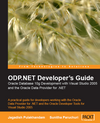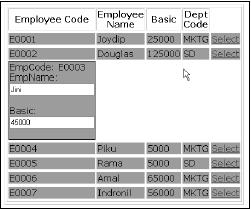|
Working with DataTableReader
Populating
a Dataset with a Single Data Table
Populating a Dataset with Multiple Data Tables
DataTableReader is complementary to a DataTable object, and is mainly used as a
type of Data Reader in the disconnected mode. The following is the modified
code:
'create connection to db
Dim cn As New OracleConnection("Data Source=xe; _
UserId=scott;Password=tiger")
Try
Dim SQL As String
'build the SELECT statement
SQL = String.Format("SELECT ename, sal, job FROM emp
WHERE empno={0}", Me.txtEmpno.Text)
'create the DataAdapter object
Dim adp As New OracleDataAdapter(SQL, cn)
'create the offline datatable
Dim dt As New DataTable
'fill the data table with rows
adp.Fill(dt)
'clear up the resources and work offline
adp.Dispose()
Dim dtr As DataTableReader = dt.CreateDataReader
'check if it has any rows
If dtr.HasRows Then
'read the first row
dtr.Read()
'extract the details
Me.txtEname.Text = dtr("ename")
Me.txtSal.Text = dtr("sal")
Me.txtJob.Text = dtr("job")
Else
'display message if no rows found
MessageBox.Show("Not found")
End If
Catch ex As Exception
'display if any error occurs
MessageBox.Show("Error: " & ex.Message)
'close the connection if it is still open
If cn.State = ConnectionState.Open Then
cn.Close()
End If
End Try
|

Book Excerpt: Retrieving Data from Oracle
Using ODP.NET
Chapter Contents
This excerpt from
ODP.NET Developer's Guide: Oracle Database 10g Development with Visual Studio
2005 and the Oracle Data Provider for .NET by Jagadish Chatarji
Pulakhandam, Sunitha Paruchuri, is printed with permission from
Packt Publishing, Copyright 2007.
|
|
|
You can observe the highlighted code, which creates a DataTableReader object by
calling the CreateDataReader method related to the DataTable object. Once the
DataTableReader is created, we can directly retrieve the column values with the
specified column names as follows:
Me.txtEname.Text = dtr("ename")
Me.txtSal.Text = dtr("sal")
Me.txtJob.Text = dtr("job")
Populating a Dataset with a Single Data Table
A dataset is simply a group of data tables. These data tables can be identified
with their own unique names within a dataset. You can also add relations
between data tables available in a dataset.
The following code gives you the details of all employees available in the emp
table by populating a dataset with only a single data table using
OracleDataAdapter:
|
Imports Oracle.DataAccess.Client
Public Class Form6
Private Sub btnGetEmployees_Click(ByVal sender As
System.Object, ByVal e As System.EventArgs) Handles
btnGetEmployees.Click
'create connection to db
Dim cn As New OracleConnection("Data Source=xe; _
UserId=scott;Password=tiger")
Try
Dim SQL As String
'build the SELECT statement
SQL = String.Format("SELECT empno, ename, job,
mgr, hiredate, sal, comm, deptno FROM emp")
'create the dataadapter object
Dim adp As New OracleDataAdapter(SQL, cn)
'create the offline datatable
Dim ds As New DataSet
'fill the data set with a data table named emp
adp.Fill(ds, "emp")
'clear up the resources and work offline
adp.Dispose()
'check if it has any rows
If ds.Tables("emp").Rows.Count > 0 Then
'simply bind datatable to grid
Me.DataGridView1.DataSource = ds.Tables("emp")
Else
'display message if no rows found
MessageBox.Show("Not found")
Me.DataGridView1.Rows.Clear()
End If
Catch ex As Exception
'display if any error occurs
MessageBox.Show("Error: " & ex.Message)
'close the connection if it is still open
If cn.State = ConnectionState.Open Then
cn.Close()
End If
End Try
End Sub
End Class
If you can observe the highlighted code in the above script, we are creating a
new DataSet object, populating it with a DataTable named "emp" (which contains
all the rows) and finally assigning the same DataTable to the grid. The output
for the above code would look similar to the figure in the section Retrieving
Multiple Rows into a Data Table Using OracleDataAdapter.
Populating a Dataset with Multiple Data Tables
Now, let us add more than one data table into a dataset. The following code
retrieves . a list of department details into a data table named Departments
and another list of employee details into a data table named Employees:
Imports Oracle.DataAccess.Client
Public Class Form7
Private Sub btnData_Click(ByVal sender As
System.Object, ByVal e As System.EventArgs) Handles
btnData.Click
'create connection to db
Dim cn As New OracleConnection("Data Source=xe; _
UserId=scott;Password=tiger")
Try
Dim ds As New DataSet
Dim adp As OracleDataAdapter
adp = New OracleDataAdapter("SELECT deptno,
dname, loc FROM Dept", cn)
adp.Fill(ds, "Departments")
adp.Dispose()
adp = New OracleDataAdapter("SELECT empno, ename,
job, mgr, hiredate, sal, comm, deptno FROM
Emp", cn)
adp.Fill(ds, "Employees")
adp.Dispose()
Me.DataGridView1.DataSource = ds
Me.DataGridView1.DataMember = "Departments"
Me.DataGridView2.DataSource =
ds.Tables("Employees")
Catch ex As Exception
'display if any error occurs
MessageBox.Show("Error: " & ex.Message)
'close the connection if it is still open
If cn.State = ConnectionState.Open Then
cn.Close()
End If
End Try
End Sub
End Class
From the above highlighted code, you can easily observe that we are retrieving
two different result sets (identified by Departments and Employees) into the
same dataset. The following code fragment creates the Departments data table:
adp = New OracleDataAdapter("SELECT deptno, dname,
loc FROM Dept", cn)
adp.Fill(ds, "Departments")
adp.Dispose()
The following code fragment creates the Employees data table:
adp = New OracleDataAdapter("SELECT empno, ename, job,
mgr, hiredate, sal, comm, deptno FROM Emp", cn)
adp.Fill(ds, "Employees")
adp.Dispose()
Those two result sets are automatically created as two data tables within the
same dataset. Once the dataset is populated, we can present them with two
different grids (two different methods) as follows:
Me.DataGridView1.DataSource = ds
Me.DataGridView1.DataMember = "Departments"
Me.DataGridView2.DataSource = ds.Tables("Employees")
The output for this code would look similar to the following figure:

Page 1
| Page 2
|
page 3 |
page 4 |
page 5 |
page 6 |
page 7 |
page 8
|